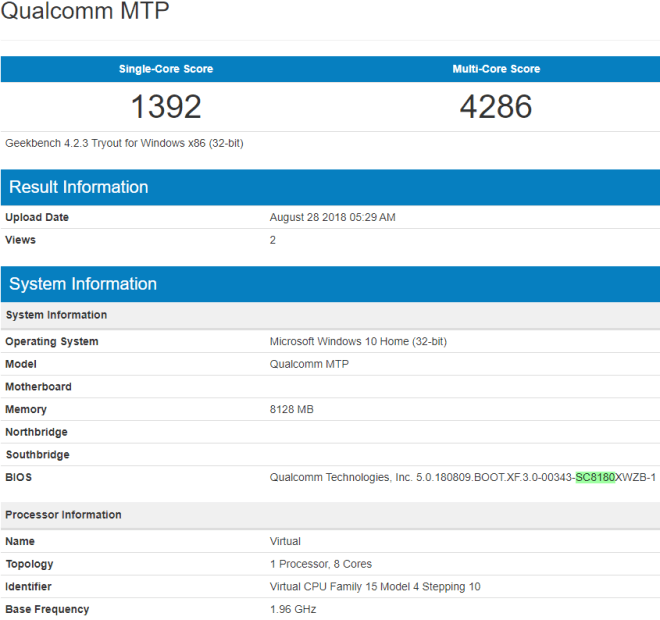Everybody knows Qualcomm for their successful Snapdragon series of CPUs for mobile phones, but not too many probably know how invested the company now is in creating processors for laptops and 2 in 1s. The first generation of ACPC (Always Connected PC) launched at the beginning of the year with the Snapdragon 835 wasn’t a huge success, as the SoC wasn’t able to support lots of Microsoft apps. Fast forwarding to today, the latest chip for PCs to hit the market is the new Qualcomm Snapdragon 850 clocked at 2.96GHz, but that’s only the beginning.
According to a notorious leaker – Roland Quandt – we do indeed know more about the upcoming Qualcomm Snapdragon 8180 CPU, the one that is expected to challenge Intel’s 15W TDP offerings. The new details come directly from the benchmark app Geekbench 4, where a device showed up on a mobile test platform (MTP) equipped with the rumored much Snapdragon 8180 chip.
Roland pointed out that MTP does not only represent mobile smartphones. In fact, we previously had a device named “SDM1000” on the same platform, which was Qualcomm’s first dedicated notebook platform processor. This test platform is also based on Microsoft’s Win10 32bit system and enlists 8GB of RAM; the setup allowed the machine to achieve 1392 points in single core and 4286 in multi-core.

According to the Geekbench page (now removed), the Snapdragon 8180 comes with eight cores and a minimum frequency of 1.96GHz, but we should ignore that as – for example – the SD 845 shows up with 1.77Ghz when it can actually go up to 2.8Ghz.
Roland then also suggested that the Snapdragon 8180 will have a 15W TDP with a chip size of 20x15mm and it’ll be based on a modified version of the ARM Cortex-A75 or -A76 architecture.
So, how does this CPU compare to Intel’s alternatives? Well, the closest one as far as Geekbench scores go is the Intel Pentium Gold 4415Y from the Microsoft Surface Go. This specific Intel chip only needs 6W watts of power and achieves the same performance with just two cores. That said, these results were taken on a 64-bit version of Windows 10, meanwhile the Snapdragon 8180 ran on a 32-bit OS. So we can’t really compare the two yet.
What we actually know though, is that ASUS is already working on a Snapdragon 8180 powered laptop, namely called ASUS Primus.




murdic
2 to the 32nd power is 4.3 Gb. 32-bit systems are physically limited to 4Gb RAM. The OS can’t use 8 Gb.
Benjiro
> So, how does this CPU compare to Intel’s alternatives?
The real alternative is the J5005 or J4105:
https://browser.geekbench.com/v4/cpu/compare/9688296
Cost 160 Euro for the Intel Nuc version. Or you can get your hands on the J4105 in a MATX board for 75 euro.
The J5005 is a 10W CPU. My own tests show it runs at 6W ( complete system with ram + SSD ), at 10W for good activity / stressed and 14W totally stressed with prime ( unrealistic ).
Benjiro
And lets hope those results for the Snapdragon 8180 are ARM based results with emulation because if those are the pure ARM result, you can imagine the performance hit with the emulation on top. Where as the J5005 needs no emulation at all.
Chupa
wasn’t the main reason for AMD to create a 64 bit windows system to break the memory barrier (and promote their 64 bit procssor what as way ahead of intel)?
A 32bit windows pc can only address a bit over 3 MB the rest is u used.
What is the reason for a non intel/amd processor what can do only 32 bit windows 10 and has 8GB???
Now if it would support win 7 and 8.1 that would be a reason to buy that and there the 32 bit with 4gb would actually work in a low end system.
David
32Bit Windows can access up to 128GB of memory, if I am not mistaken. They use Physical Address Extension to do this in Windows. While a single process is still limited to 4GB of memory access, the system isn’t limited to just 4GB. You can read more about it here: https://docs.microsoft.com/en-us/windows/desktop/memory/physical-address-extension
filn
There is an interesting discussion about the Snapdragon 850 in the Lenovo Yoga C630.
“There is no emulation of x86 on ARM with these devices since this would be way too slow. It’s binary translation with results getting cached. So first time you start a 32-bit x86 app on such an ARM thing it will be pretty slow but subsequent runs will be a lot faster. And the majority of calls will be native anyway since libs and kernel run native.
A typical reviewer starts such an app one time just to write ‘awfully slow’ in his review and heads over to the next ‘area of test’.”
“Things will be sluggish (as in random stutters and slow startups) until MS:
1) provide more means for devs to go native arm64 (MS’re moving in that dir, just slowly), and
2) don’t just WoW but start re-building their apps for arm”
filn
discussion source:
https://www.cnx-software.com/2018/08/31/lenovo-yoga-c630-wos-snapdragon-850-laptop/#comments
Brad
I could be mistaken but I remember reading that the difference between a 32bit versus 64bit OS has much more to do with the size of the compiled executable files and the amount of memory the OS and apps can access (since more bits means a larger address). It said the difference in performance was less (don’t remember if it was close to zero or what though). I don’t remember where I read it but I think it was talking about some flavor of Linux OS.